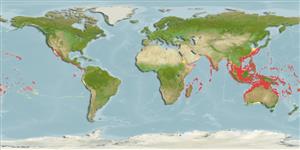>
Acanthuriformes (Surgeonfishes) >
Zanclidae (Moorish idol)
Etymology: Zanclus: Greek, za = an augmentative particle + Greek, agklino = to be on one´s back (Ref. 45335).
More on author: Linnaeus.
Environment: milieu / climate zone / depth range / distribution range
Écologie
marin récifal; profondeur 0 - 182 m (Ref. 9710), usually 5 - 182 m (Ref. 27115). Subtropical; 24°C - 28°C (Ref. 27115); 32°N - 37°S, 21°E - 70°W
Indo-Pacific: East Africa to Rapa and Ducie islands, north to southern Japan and the Hawaiian Islands, south to the Lord Howe Island. Eastern Pacific: southern Gulf of California to Peru (Ref. 9267).
Taille / Poids / Âge
Maturity: Lm ? range ? - ? cm
Max length : 23.0 cm TL mâle / non sexé; (Ref. 6113); common length : 21.0 cm NG mâle / non sexé; (Ref. 5755)
Description synthétique
Clés d'identification | Morphologie | Morphométrie
Épines dorsales (Total) : 6 - 7; Rayons mous dorsaux (Total) : 39 - 43; Épines anales: 3; Rayons mous anaux: 31 - 37. Strongly compressed discoid body. Tubular snout with a small mouth containing numerous elongate bristle-like teeth. Dorsal spines elongated into a whip-like filament.
Inhabit turbid inner lagoons, reef flats, and clear seaward rocky and coral reefs (Ref. 1602, 48637). Benthopelagic (Ref. 58302). Generally encountered in small groups of 2 or 3 individuals (Ref. 9267). Adults occur singly, in pairs and occasionally are seen in large schools (Ref. 48637). Feed on small encrusting animals (Ref. 6113). Size of metamorphosis from postlarva to juvenile is 7.5 cm (Ref. 9267). The long pelagic larval stage is the reason for the wide distribution and strong colouration that shows no geographical variation (Ref. 48637). Popular aquarium fish but rarely survives in tanks (Ref. 1602). Minimum depth reported taken from Ref. 128797.
Life cycle and mating behavior
Maturities | Reproduction | Spawnings | Egg(s) | Fecundities | Larves
Myers, R.F., 1991. Micronesian reef fishes. Second Ed. Coral Graphics, Barrigada, Guam. 298 p. (Ref. 1602)
Statut dans la liste rouge de l'IUCN (Ref. 130435)
Menace pour l'homme
Harmless
Utilisations par l'homme
Pêcheries: pêcheries vivrières; Aquarium: Commercial
Outils
Articles particuliers
Télécharger en XML
Sources Internet
Estimates based on models
Preferred temperature (Ref.
123201): 20 - 29, mean 27.7 °C (based on 4016 cells).
Phylogenetic diversity index (Ref.
82804): PD
50 = 1.5000 [Uniqueness, from 0.5 = low to 2.0 = high].
Bayesian length-weight: a=0.01738 (0.00674 - 0.04483), b=3.06 (2.84 - 3.28), in cm total length, based on LWR estimates for this (Sub)family-body shape (Ref.
93245).
Niveau trophique (Ref.
69278): 2.5 ±0.00 se; based on food items.
Fishing Vulnerability (Ref.
59153): Low vulnerability (13 of 100).
Nutrients (Ref.
124155): Calcium = 44.8 [19.5, 73.0] mg/100g; Iron = 0.697 [0.404, 1.262] mg/100g; Protein = 18.8 [17.5, 20.0] %; Omega3 = 0.175 [0.095, 0.315] g/100g; Selenium = 22.8 [10.2, 47.4] μg/100g; VitaminA = 29.5 [6.8, 126.5] μg/100g; Zinc = 1.05 [0.66, 1.62] mg/100g (wet weight);
